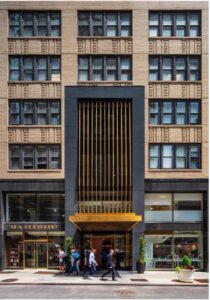What Hybrid Work Looks Like For a CRE Firm


The saying that sauce for the goose is sauce for the gander—these days phrased as good for the waterfowl—has been around for many hundreds of years. When it comes to commercial real estate companies and hybrid work, it’s true. CRE or some other kind of office tenant, there are those that swear one way or the other, and probably a lot more scratching their heads, trying to understand what will work best.
If owners and operators heavily used hybrid work, the conversations would seem easy to envision.
“You really need to be back in the office, to keep corporate culture going, to keep collaboration and innovation in your organization,” the building owner would say.
“Uh, but you’re working hybrid,” the tenant would answer.
“Oh. Right.”
It would be like a vegan owner of a burger restaurant urging customers to chow down on an extra helping of beef.
But things aren’t so simple or clear.
HYBRID BY SUBSECTOR
“The occupier of that side of the equation have been slower to return to offices than those who are in the real estate busi-ness themselves,” Darin Buelow, principal and global lead for location strategy at Deloitte Consulting, says. “If you’re in the real estate business, you have an intrinsic sensibility that it would be good to try to demonstrate and lead from the front, that your work can be done in the office. If that’s how you make your company, it makes sense that they’re trying to get people to come in.”
Part of the dynamic depends on where a CRE company fits into the industry.
“I have a gut response even to the concept,” says AmTrust RE President Jonathan Bennett. “You don’t really see it that much. The drinking of the Kool-Aid is what you see some reports on, that owners want to bring people back to the office because it’s a self-fulfilling prophecy. That seems to be a fairly consistent theme, that real estate companies aren’t huge fans of hybrid.”
“Particularly on the landlord and broker side, you certainly see them eating the food that they cooked,” Jason Aster, managing director of KBA Lease Services, a lease review company, says. “I know a lot of landlords that were back in the office after the pause.”
“Because we’re in the office business, we came back in 2020, then we looked around and went, where is everybody?” Jeff Shaw, CEO of integrated real estate investment manager Bridge Commercial Real Estate, says. “We stayed in and did hybrid early. We were able to figure out pretty quickly that we could keep people feeling safe and function in a hybrid environment. We provide lunches, we do a lot of activities together, and it’s helped us to maintain a very positive culture. When the world seems unsteady and there’s some stability in your company, it helps build loyalty.”
Aster says that brokerages have had more of a struggle. “Most of them embraced hybrid as there’s always an opportunity for them to work remotely but having to be in the office four days a week instead of two days,” he says. For his firm, the focus has been on creating a community that helps with retention.
“It’s not like we’ve mandated three or four days in the office,” Aster says. “We’ve mandated larger team meetings that everyone comes to.” Those meetings usually involve food or an outing.
Marx Realty, which owns several office buildings in New York, Atlanta, and Washington, D.C. is “in the office Monday through Thursday and then we work from home on Friday,” says CEO Craig Deitelzweig. “Especially the young people, they want to be in the office. The office has all the benefits of home but so much more. More space, technology, latte machines, coffee, snacks, all that kind of stuff. We have large terraces in the building. People love to work on the terraces and be outside, sort of their own private oases. We never mandated anything. We asked people to do that, and they’ve done it happily since July 2020. But we all understand we do our best work together.”
Greg Martin, principal and managing director at the Fort Lauderdale office of Avison Young, prefers that his team work in the office. “We have not employed it, but at the same time we’re out promoting this,” he says. “It works out better for our team. We never went there. Our team’s success is driven by collaboration and the fact that we’re all together.”
But nothing is set in concrete and steel. While Martin’s team works in the office, the company doesn’t mandate it for everyone.
“As far as I can tell, every company is approaching it in their own way, in their own manner,” Martin says. “It’s hard to ignore the fact that our industry is made up of independent contractors in the brokerage world. Depending on the structure of the team, I think we’ve seen the community embrace that. Companies have followed through with the technology. We are definitely employing the hybrid work model. I believe that hybrid working, flex working, is here to stay. It’s part of most staffs’ operating design. The workforce has been demanding it. Short of a few sectors, it hasn’t been a problem. People want to be able to get hold of their property manager or engineer.”
EMBRACING CHANGE
That may be the biggest lesson. Shaw says that the industry is complex and that a one-size-fits-all approach doesn’t necessarily work. “There are so many jobs and nuances of the jobs in what you’re selling and how you’re selling it, so it’s hard to generalize.”
Take Michael Silver, chairman and managing broker of global real estate occupier service provider Vestian, for example. On one hand, the company has enough offices that he starts to lose count.
“I have I don’t know how many offices,” Silver says. “I have people all over the place.” He then rattles off six offices in India, three in China, one in Mauritius, and “about 18 in the US.”
But Silver doesn’t set absolutes when it comes to making the business work. “I absolutely use one of three things,” he says. “Either I use a permanent office, or I assign a coworking space, or sometimes people want to work out of their home.”
“In the Chicago area, we have a floor in a nice office building, and it works out,” Silver adds. “In New York, we have a nice floor in a small building. Not everyone comes into the office. I never had a mandate that salespeople sit in the office rather than go out and sell. If we’re starting a new situation and have 4 or 5 people, we’d use a WeWork or Industrious. I’m not unhappy about it. We screen the people ahead of time, the people are out with their customers, and I save money. Money I save in office space I can put toward technology or recruiting.”
“Cherre was always hybrid,” says L.D. Salmanson, CEO of the data integration and analysis company. “We’ve always had an office, but we’ve never forced people to the office. However, what I used to say before the pandemic is, ‘If I don’t know your face because I haven’t seen you around enough, that’s not good. Be on your own schedule but I’d like to know your face.’”
They had Monday morning meetings and that was the day the office was mostly full. Then came the pandemic. Cherre was already set up for people to work remotely. “Clearly mostly people are home and every once in a while, they’re here,” Salmanson says. “I’m not planning to change that. If I’m forcing people to go to the office, I have to pay more money.”
Not just in salary, because convenience has a value to workers, but in hard costs. The company currently employs about 140 people and will be hiring. If in the office, “that’s desks” with computers and phones, Salmanson explains.
“I’d need a lot more conference rooms, a lot more phone rooms,” he adds. “If I forced everyone to go back to the office now my best employees would leave. It’s still the case that you have to compete for top talent. I couldn’t get them back in the office and there’s a little leniency on price if someone is remote, people are conditioned, and I don’t know that I’d win. I’m skeptical that I’d see the perceived benefits.”
It makes things more complicated. “Does it mean I’d need a new way to onboard people? Yes,” Salmanson says. It’s harder to do certain types of training, like in sales. “But nobody asked my opinion. My opinion doesn’t matter. I have to be candid about where I am.”
Finally, there’s the question of whether pushing to show office usage in CRE actually helps the business, particularly the office sector, as multifamily, industrial and logistics, medical, retail, and other such uses may have a more naturally high occupancy rate.
Right now, there’s no evidence suggesting that CRE companies working in their offices are inspiring others to do the same.
“We know writ large looking at all kinds of occupiers, occupancy across the country seems to be around 40%, 45%,” Deloitte’s Buelow says. “If we don’t have a recession, I would not expect that number to move up over the mid-40s very much. Then the question becomes how long will tenants continue to operate with mostly empty spaces before they decide to do something about it? I think most are waiting and I’m wondering how much longer most of them will wait. As leases come up for renewal, that’s a natural period when tenants can make deci-sions about what they’re going to do.”
And when they make that decision, they’re probably not thinking, “I wonder how much time the broker spends at a home office?”